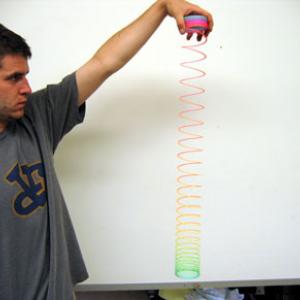College of Liberal Arts & Sciences
1G20.45 - Dropped Slinky
Hold one end of the Slinky high in the air so that the other end is off the ground and visible. Let go of the top end and watch as the bottom end remains in place until the whole spring has contracted to it's minimum length. Video capture will help with the spring observations and calculations.
Note that the top end of the Slinky falls faster than "g".
- Calvin Berggren, Punit Gandhi, Jesse A. Livezey, and Ryan Olf, "A Tale of Two Slinkies: Learning about Model Building in a Student-Driven Classroom", TPT, Vol. 56, #3, Mar. 2018, p. 134.
- "Figuring Physics", TPT, Vol. 49, #7, Oct. 2011, p. 408.
- Mark Graham, "Analysis of Slinky Levitation", TPT, Vol. 39, #2, Feb. 2001, p. 90.
- Martin Gardner, "A Slinky Problem", TPT, Vol. 38, #2, Feb. 2000, p. 78.
- John D. McGervey, "Hands-on Physics for Less Than a Dollar per Hand", TPT, Vol. 33, #4, Apr. 1995, p. 238.
- Ronald Newburgh, George M. Andes, "The Falling Slinky", TPT, Vol. 33, #9, Dec. 1995, p. 586.
- R. C. Cross, M. S. Wheatland, "Modeling a Falling Slinky", AJP, Vol. 80, #12, Dec. 2012, p. 1051.
- J. M. Aguirregabiria, A. Hernandez, and M. Rivas, "Falling Elastic Bars and Springs", AJP, Vol. 75, #7, p. 583, July 2007.
- M. G. Calkin, "Motion of a Falling Spring", AJP, Vol. 61, #3, Mar. 1993, p. 261.
- Paul Doherty, "Drop a Slinky", The Exploratorium, June 1999.
Disclaimer: These demonstrations are provided only for illustrative use by persons affiliated with The University of Iowa and only under the direction of a trained instructor or physicist. The University of Iowa is not responsible for demonstrations performed by those using their own equipment or who choose to use this reference material for their own purpose. The demonstrations included here are within the public domain and can be found in materials contained in libraries, bookstores, and through electronic sources. Performing all or any portion of any of these demonstrations, with or without revisions not depicted here entails inherent risks. These risks include, without limitation, bodily injury (and possibly death), including risks to health that may be temporary or permanent and that may exacerbate a pre-existing medical condition; and property loss or damage. Anyone performing any part of these demonstrations, even with revisions, knowingly and voluntarily assumes all risks associated with them.

